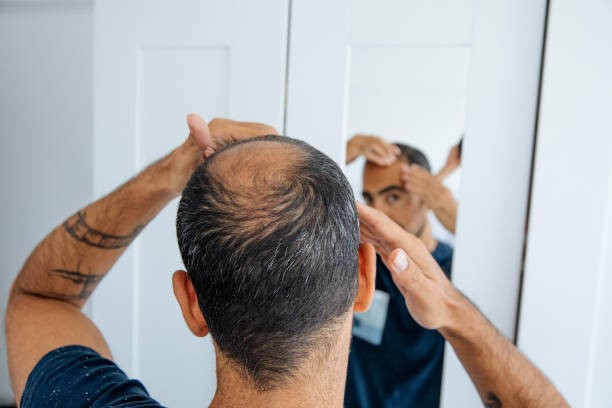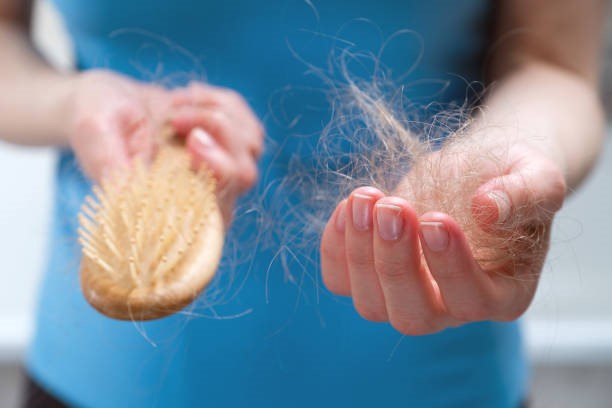
Alopecia (hair loss)
Alopecia (hair loss)
Alopecia, hair loss or baldness, is a dermatological condition of the hair follicles. It is found in both women and men and can be associated with the existence of certain hereditary factors, age-specific hormonal changes or other physiological (for example, pregnancy) or medical conditions, with the presence of certain diseases or with certain treatments.
About hair loss
Approximately 50-100 hairs can be lost daily, as a result of the normal growth cycle of the hair follicle. When the hair loss is greater (over 150 hairs), it is important to visit the dermatologist to find out the cause and prescribe the appropriate treatment.
If you notice massive thinning or areas without hair, you may have an inherited condition called androgenetic alopecia (also known as male or female pattern baldness), the most common cause of premature hair loss. Other factors that can cause hair loss include certain immune diseases, exposure to toxic chemicals, stress, burns, various skin conditions, and chemotherapy. Many medications, such as those used to treat heart disease, depression, hormonal disorders, and other conditions, can, in rare cases, cause hair loss.
Causes and risk factors
Normal hair loss on the scalp does not cause visible hair thinning, because the hairs that fall out are replaced by new ones. This process is disrupted when the hair growth cycle is interrupted or when the hair follicles are destroyed or replaced by scar tissue.
Hair loss is associated with one or more of the following factors:
Family history (heredity). The most common cause of hair loss is a hereditary condition, alopecia (baldness, baldness) with a male or female pattern. It usually appears gradually, with age, having a predictable pattern: the receding of the hairline and the appearance of areas of baldness in men; thinning hair appears in women.
Hormonal changes and the presence of some diseases. There are many causes that can cause temporary or permanent hair loss, such as hormonal changes specific to pregnancy, childbirth, menopause and thyroid diseases. Among the medical conditions that lead to hair loss are: alopecia areata (which causes hair loss in some areas of the scalp), some infections such as ringworm (tinea capitis or trichophytia, a fungal infection of the scalp and follicles manifested by hairless areas and crusts which produce itching). Another cause is trichotillomania, a disorder manifested by a person’s pathological and obsessive desire to tear their hair).
Administering medications or supplements. Hair loss can be an adverse effect of the administration of certain drugs such as those indicated in various therapies for cancer, arthritis, depression, heart disease, gout, hypertension.
Radiotherapy to the head. In the case of people who have undergone radiation therapy in the head area, it is possible that the hair no longer has the same growth rate as before.
Situations involving strong stress. Many people may experience thinning hair a few months after experiencing an intense physical or emotional shock. In this case, the hair loss is temporary.
Excessive styling and some hair treatments. Some hairstyles such as hair extensions and Afro braids can lead to traction alopecia. Hair treatments with hot oil can lead to inflammation of the hair follicles and hair loss. If scars also appear, hair loss can be permanent.
Risk factors for hair loss include:
- Family history of baldness
- Age
- Significant weight loss
- Administering treatments such as those for diabetes or lupus
- The stress.
Symptoms
Depending on the cause, hair loss can manifest itself differently. For example, it can appear suddenly or gradually, or it can affect only the scalp or the whole body. Hair loss can be temporary or permanent.
Signs and symptoms of hair loss include:
Gradual thinning of the hair at the level of the crest. It is the most common type of hair loss and is found in both women and men as they age. In the case of men, the hair begins to recede at the level of the forehead in a line that resembles the letter M. In women, the hairline is usually kept at the level of the forehead, but gradual thinning occurs in parts.
The appearance of round areas or in the form of spots. Some people may have large bald patches. This type of hair loss usually only affects the scalp, but sometimes it can also appear on the beard or eyebrows. Sometimes itchiness (pruritus) and pain in the skin appear before hair loss.
A strong physical or emotional shock can cause hair loss. Hair can fall out in tufts after combing, washing or when it is gently pulled. In this case, there is usually a general weakening of the hair, not bald areas.
Loss of body hair. The presence of some diseases and following some treatments such as chemotherapy can cause hair loss on the whole body. Usually, the hair grows back.
The appearance of crusts on the scalp. This is a sign of infection and is accompanied by hair loss, redness, inflammation and sometimes discharge.
Types of alopecia
Androgenic alopecia is a genetically determined condition and is present in both men and women. It is manifested by a thinning of the hair in the fronto-parietal area. In men, it can appear as early as adolescence or from 20 years old. In women, it can be associated with polycystic ovary syndrome and usually occurs after 40 years, the main manifestation being the thinning of the hair on the entire scalp. It is considered to occur more frequently in men, but menopausal women are also frequently affected.
Alopecia areata is an autoimmune condition. It is a severe alopecia, which means that it is manifested by the presence of patches on the scalp completely devoid of hair. Alopecia areata has a complex pathogenesis, and the evolution of the disease is unpredictable: it can remit spontaneously or it can be generalized, with complete hair loss. It is more frequent in women.
Cicatricial alopecia is characterized by the destruction of the hair follicle and by the formation of scar tissue.
Telogen Effluvium is a frequent form of diffuse alopecia, which manifests itself a few months after the body has been subjected to a major stress, such as the one that occurs after a disease or a major surgical infection. It can also appear after a sudden change in hormone levels, for example, after childbirth.
Tinea capitis (fungal infection of the scalp) is a form of alopecia caused by certain types of fungi on the scalp.
Traction alopecia is caused by styling techniques that subject the hair to extreme heat, curling or strong chemicals (dyed, permanent styling).
Classification of alopecia
Male alopecia – Hamilton-Norwood scale
This scale describes the different characteristics of the types of alopecia found in men.
Type 1: minimal or reduced hair loss in the frontal area
Type 2: hair loss in the fronto-temporal area. The hair in the temple region is visibly thinning
Type 3: hair loss especially in the vertex region (crown area). It is the minimum level from which it is considered to be bald.
Type 4: the vortex area increases. Hair loss in the frontal area is greater than that described in type 3. A strip of hair separates the two regions affected by baldness.
Type 5: hair loss is extensive, and the two areas of baldness are separated by a thin strip of hair.
Type 6: the anterior and posterior hairless regions merge and a widening of the affected area occurs.
Type 7: in this stage, only a portion of the initial hair remains, at the level of the ears, which is joined to the neck.
Female alopecia – Ludwig classification

This classification is used by specialists to describe the types of alopecia found among women.
Type 1: diffuse hair loss is observed in the crest area
Type 2: hair loss is more pronounced in the region of the crest
Type 3: hair loss is severe, the scalp can be easily seen.
Diagnosing
For a correct diagnosis, the doctor will examine you and recommend some tests:
Blood tests. These are indicated to discover possible medical causes of hair loss. For example, certain hormone levels can be determined: testosterone, dihydrotestosterone.
The hair pulling test. The doctor will pull a strand to see how many hairs fall out.
Scalp biopsy and histological examination. The doctor collects a sample from the scalp to determine if an infection is the cause of the hair loss.
Trichoscopy (hair and scalp videodermoscopy) consists in examining the hair and scalp with the help of the dermatoscope or videodermoscope, a special magnifying glass.
Treatment
There are effective treatments for some types of alopecia.
The doctor can recommend the application of local treatments, the use of special shampoos, depending on the type of hair. It is recommended to change the lifestyle, adopt a balanced diet, which includes the vitamins and trace elements necessary, among others, for hair growth.
It is also necessary to adopt measures such as: avoiding hair trauma and frequent dyeing.
Treatments for hair loss include medication and surgery.
Medication
Minoxidil. Applied twice a day to the scalp, this over-the-counter medicine is available in a concentration of 2% or 5% in liquid form or 5% in foam form. The solution with a concentration of 5% is more effective in men and probably also in women, although the one with a concentration of 2% is recommended for women. It reduces hair thinning and stimulates hair growth in the upper area of the scalp.
Finasteride. It is a medicine released with a medical prescription, which is administered orally. The drug lowers the level of one of the hormones associated with androgenetic alopecia, but has been shown to be effective only for men and is not approved for use in women.
Other medicines. For men, other medical treatment options against alopecia are dutasteride, and for women oral contraceptives or spironolactone.
Surgical treatment
Hair transplant. A treatment option for alopecia is hair transplantation. The intervention involves the transplantation of healthy hair follicles from other parts of the scalp to the areas affected by baldness. The procedure involves two to three sessions, at an interval of almost four months. It is very likely that in the case of alopecia due to hereditary causes, the alopecia will progress despite surgical treatment.
Other surgical procedures
Other surgical procedures are scalp reduction (removing bald patches from the scalp, bringing together areas with hair) and scalp flap transplantation (by moving hairy segments of the scalp to bald areas).
Solutions for the regeneration of eyelashes
After people noticed that a prescription glaucoma drug, bimatoprost (Lumigan), made eyelashes longer and thicker, the drug’s makers applied for and won approval from the US Food and Drug Administration. (FDA) for a cosmetic formulation of this drug, issued with a medical prescription. In Europe, the drug is used for the treatment of glaucoma and is released on the basis of a medical prescription, due to the possible adverse reactions that may occur. Cosmetic products containing bimaprost are sold on the market.
Prevention of hair loss
Most cases of alopecia are hereditary, and in this case hair loss is not preventable.
There are several measures that help prevent hair loss in other situations:
- Avoid compulsive hair pulling
- Treat your hair gently when combing or washing it.
- Avoid excessive hair treatments.
- Limit the administration of medicines and supplements that can cause hair loss.
- Protect your hair from the sun’s rays or other sources of ultraviolet light.
- Stop smoking. Some research shows an association between smoking and male pattern baldness.
- If you are undergoing chemotherapy, ask your doctor about a cooling helmet, which reduces hair loss during chemotherapy.
Documentation sources:
https://www.mayoclinic.org/diseases-conditions/hair-loss/symptoms-causes/syc-20372926
https://www.health.harvard.edu/a_to_z/hair-loss-a-to-z
https://www.aad.org/why-hair-falls-out
https://www.injertocapilar-alopecia.es/fr/alopecie/classification-de-lalopecie-par-perte-des-cheveux